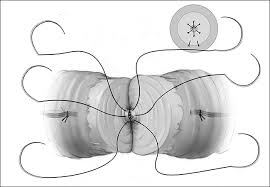How do vasectomies and vasectomy reversals work? A vasectomy is a surgical procedure that prevents males from getting their partner pregnant. After this surgery, the sperms won’t mix with the semen. This indicates that the body will produce sperms, but it won’t leave the male body. By eliminating sperms from semen, men can prevent pregnancy. However, the person getting vasectomy will still have ejaculation and orgasm.

(Source)
Vasectomy is a less invasive treatment that takes about 30 minutes. Since it’s not an invasive treatment, a professional urologist will perform the treatment in the office. After the surgery, you can leave for home and even drive your car. The doctor may refer to this procedure as male sterilization. But, your friend might call it getting snipped or the snip.
Conventional Vasectomy
To perform the procedure, the urologist makes tiny cuts on the scrotum and takes out two tubes. These tubes are vas deferens and they supply sperms to the penis from testicles. Each testicle contains one vas deferens. The doctor cuts the tube, leaving a short gap in between. The doctor will cut vas deferens in a single cut. Sometimes, a second cut is also required. They might stitch both ends to ensure that sperms don’t reach the other end. The stitch might dissolve with time, while both ends of the tube stay adjoined.
No-Scalpel Vasectomy
While performing no-scalpel vasectomy, the doctor feels vas deferens from the scrotum’s skin and holds it with a clamp. The clamp keeps the vas deferens in place during the procedure. Then the urologist will make a tiny hole on the skin to expose the tube. They’ll grab the tube and pull them out. They will lift each tube and cut. Then they seal the tube through stitching or searing.
Effectiveness of Vasectomy
Vasectomy is an effective treatment with an almost 100% success rate. However, in rare cases, the tubes rejoin and sperms mix with semen. This happens when both ends of the tube meet again. Although it is a rare case, in this condition you will get back your fertility.
Also, soon after vasectomy, the sperms leave the body for a while. That’s why the doctor will ask you to visit for follow-up tests and evaluation. During this time, you should avoid having sex. Once the doctor confirms that there are zero percent sperms in the semen, you can have sex without worrying about getting your partner pregnant.
Vasectomy Reversal
Sometimes, people regret getting a vasectomy and want to have babies. They have an option for vasectomy reversal. During this procedure, the doctor reconnects vas deferens allowing the sperms to mix with the semen and ejaculate from the body.
However, in rare conditions, the tube joins with epididymis. When this happens, joining the tub won’t help. So, the doctor separates the vas from the epididymis under a microscope. After successfully removing the tube, they connect them.
After vasectomy removal, you have to visit the doctor for follow-up. During this time, the doctor will ensure sperm production. Normally, when people take 10 to 15 years to get vasectomy reversal, they lose the ability for sperm production.
You can undergo vasectomy reversal for many reasons. This includes a change of heart, remarriage, or perhaps your spouse wants to have a baby.

Treatment of Vasectomy Reversal
Urologists perform reversal in a come-go-basis. This means that it’s not an invasive treatment. It is an outpatient treatment, performed in a doctor’s office. You will stay awake throughout the vasectomy reversal. However, when the doctor uses a surgical microscope, they will inject anesthesia. The urologist and anesthesiologist will collaborate to make the surgery successful.
Microsurgery is an effective surgery and requires a professional urologist to perform. They’ll use a high-powered microscope to separate the small tubes. Vas deferens tubes are tiny, especially when connected with the epididymis, it is hard to operate. Furthermore, the stitches are thinner than the hair and eyelashes.
Once you are asleep, the urologist will identify the exact spot of the tube and make tiny cuts on the scrotum. Since the tubes are stitched they will cut vas deferens from edges. That way they get rid of the stitches. As a result, the tubes will wide open. The urologist will take vassal fluid samples from the tube end coming from the testis. That way, they can confirm whether you are producing sperm or not.
Once they assure that you can produce sperm, they will join both ends of the vas deferens and stitch. On the other hand, if your fluid won’t contain sperm, they will perform another surgery to treat sperm production.
Vasectomies and Vasectomy Reversals: Conclusion
Do you want to undergo vasectomy or vasectomy reversal in New York? If yes, then you should consult Fifth Avenue Urology. Our expert urologist Dr. Yaniv Larish has many years experience treating all urological conditions in men and women.
Schedule a consultation today
FIFTH AVENUE UROLOGY
Dr. Yaniv Larish
4 East 76th Street
New York, NY 10021
212-675-3186

 Dr. Larish is a urologist and surgeon treating women and men with a variety of urological conditions. His expertise is in treating complex kidney stones, enlarged prostates (BPH), incontinence, erectile dysfunction, infertility, and urological oncology (prostate, bladder, kidney, and adrenal cancers). He is an expert in general urology and is often consulted for second opinions.
Dr. Larish is a urologist and surgeon treating women and men with a variety of urological conditions. His expertise is in treating complex kidney stones, enlarged prostates (BPH), incontinence, erectile dysfunction, infertility, and urological oncology (prostate, bladder, kidney, and adrenal cancers). He is an expert in general urology and is often consulted for second opinions.







 Under normal circumstances, the
Under normal circumstances, the  A vasectomy reversal, as the name implies, is when a person gets a reversal of their vasectomy for any reason they see fit. Now, unlike a vasectomy, this is a little more complicated, and you will always be unconscious during the procedure. There are two methods of reversing a vasectomy, both of which are simple on paper but quite difficult in practice.
A vasectomy reversal, as the name implies, is when a person gets a reversal of their vasectomy for any reason they see fit. Now, unlike a vasectomy, this is a little more complicated, and you will always be unconscious during the procedure. There are two methods of reversing a vasectomy, both of which are simple on paper but quite difficult in practice.